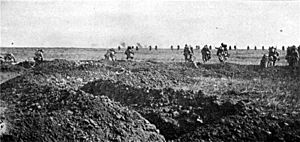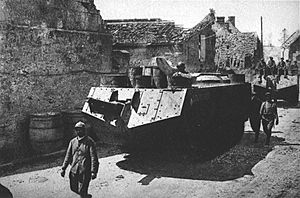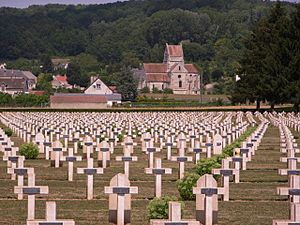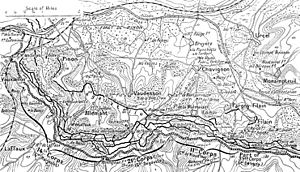Nivelle offensive facts for kids
Quick facts for kids Nivelle offensive |
|||||||
|---|---|---|---|---|---|---|---|
| Part of the Western Front of the First World War | |||||||
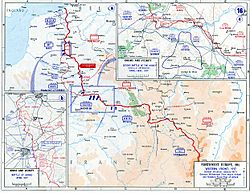 The Western Front, 1917 |
|||||||
|
|||||||
| Belligerents | |||||||
| Commanders and leaders | |||||||
| Strength | |||||||
| 850,000 troops 7,000 guns, 128 tanks |
c. 480,000 | ||||||
| Casualties and losses | |||||||
| French: 187,000 Russian: 5,183 |
c. 163,000 (15,000–20,780 POW) |
||||||
The Nivelle Offensive was a major military operation during the First World War. It took place from 16 April to 9 May 1917. This attack was led by General Robert Nivelle, who was the commander of the French armies. The main goal of the French was to break through the German defenses very quickly. They hoped to win the war in just 48 hours.
The plan involved attacks by both French and British forces. The British attacked first near Arras. This was meant to distract German troops. Then, the main French attack happened at the Chemin des Dames ridge. This part of the battle is also known as the Second Battle of the Aisne.
While the attacks had some success in gaining ground, they did not achieve the big breakthrough Nivelle had hoped for. The fighting was very costly, with many soldiers injured or killed. This led to problems with morale among the French troops. General Nivelle was later replaced by Philippe Pétain. After this, the French army focused on defending their positions.
What Led to the Offensive?
Planning the Big Attack
After difficult battles in 1916, General Robert Nivelle took charge of the French armies. He believed a huge attack could win the war quickly. His plan was to use a massive artillery bombardment. This would clear the way for French soldiers to break through German lines.
The plan was developed in late 1916. However, there were many delays and information leaks. By April 1917, the German army knew a lot about the upcoming attack. They used this information to strengthen their defenses. They added more forts and brought in extra troops.
Getting Ready for Battle
The French gathered a huge number of soldiers and weapons. About 1.2 million troops and 7,000 artillery guns were ready. The main target was the German positions along the Chemin des Dames ridge. This ridge was a strong defensive line.
German planes flew over the front lines. They took pictures and saw the British getting ready for an attack. They saw many soldiers, vehicles, and new railways. By early April, the Germans were sure an attack was coming. They also brought in more planes and improved their communication systems. This helped them prepare their defenses.
Soldier Morale
The soldiers had been fighting for a long time. Battles like Verdun had caused many casualties. The tough conditions made many soldiers very tired and upset. They felt their sacrifices were not always appreciated.
Even strong units were starting to lose hope by early 1917. The French commander, Pétain, tried to help by regularly rotating tired divisions. This helped some, but many soldiers were still affected by the long war.
The Battle Begins
Attacks at St. Quentin and Arras
The offensive started with preliminary attacks. The French Third Army attacked German observation points near St. Quentin. They captured some German defenses. However, the main attack on 13 April did not make much progress. German machine guns stopped them.
On 9 April, the British Third and First armies attacked near Arras. This was part of the Battle of Arras. The British made a big advance, pushing 6,000 yards (about 5.5 km) into German lines. This was the deepest advance since trench warfare began. They also captured Vimy Ridge, a very important high ground.
The British attacks caused many German casualties. They also forced the Germans to send more troops to this area. This was exactly what the Allies wanted. It helped distract the Germans from the main French attack. The British continued to fight, capturing more ground. By 16 May, they had taken 254 German guns.
Fighting at Chemin des Dames
The main French attack began on 16 April at 6:00 a.m. It was a misty morning. German machine gunners caused many casualties among the French infantry. Some French units had success, capturing parts of the German second line. North of Berry, they advanced about 2.5 miles (4 km).
Other French units had less success. Some were stopped or pushed back to their starting lines. The French Sixth Army took about 3,500 prisoners. However, they did not achieve the big breakthrough they wanted. Only in one place did they reach the German second position.
On the second day, General Nivelle ordered more attacks. The French Sixth Army continued to push forward. This forced the Germans to pull back to a new defensive line. The Germans left behind many guns and supplies. The French infantry advanced about 4 miles (6.4 km) to these new German positions.
By 5 May, the French Tenth Army captured the Californie plateau. The Sixth Army also advanced along the Chemin des Dames. By 10 May, the French armies had taken 28,500 prisoners and 187 guns. The advance by the Sixth Army was one of the largest made by a French army in trench warfare.
Attacks in Champagne
On 17 April, the French Fourth Army launched a supporting attack in Champagne. This battle was known as the "Battle of the Hills." It started in cold rain and snow. The French captured important hills like Mont Cornillet and Mont Blond.
They held these hills against German counter-attacks. On the west bank, one division was pushed back, but another captured Mont sans Nom. The French Fourth Army took 3,550 prisoners and 27 guns. German attacks later had some success, but French counter-attacks recaptured the lost ground.
After the Offensive
Casualties and Impact
The French military headquarters had expected about 10,000 casualties. However, the actual numbers were much higher. French medical services were overwhelmed. From 16 to 25 April, French casualties were around 134,000. This included 30,000 killed, 100,000 wounded, and 4,000 prisoners. This was one of the worst casualty rates for the French since 1914.
The British had about 160,000 casualties. Russian forces involved had 5,183 casualties. German losses were around 163,000. Many of the new French tanks were destroyed by German artillery.
The high number of casualties and the failure to achieve a quick victory had a big impact. It lowered the morale of both the soldiers and the public in France. General Nivelle was removed from his command. The French army then adopted a more defensive strategy to recover.
Continued Fighting
After the main offensive, fighting continued in certain areas. This was known as the Battle of the Observatories. Both sides fought for control of high ground on the Chemin des Dames. The Germans launched many counter-attacks. For example, from 5 May, the Germans attacked seventy times in eighty days.
Verdun
Fighting also continued at Verdun. German attacks happened on 29 and 30 June. This led to a period of attacks and counter-attacks throughout July and August. From 20 to 26 August, the French launched their Second Offensive Battle of Verdun.
The French captured several important areas and tunnels. By 26 August, they had taken 9,500 prisoners and many guns. By 9 September, they had taken over 10,000 prisoners. The German commander, Ludendorff, noted that the French army had "quickly overcome its depression."
Battle of La Malmaison
The Battle of La Malmaison took place from 23 to 27 October 1917. The French aimed to capture the village and fort of La Malmaison. This would give them control of the Chemin des Dames ridge. The Germans decided to defend their front positions strongly.
The French used gas bombardments, which made it hard for the Germans to bring supplies. French planes had also identified and destroyed German shelters. The French attacked at 5:15 a.m. on 23 October. It started raining an hour later, and many tanks got stuck in the mud.
However, the French infantry and some tanks reached their targets. They captured Fort de Malmaison, Allemant, and Vaudesson. By 25 October, they reached the Canal de l'Oise à l'Aisne. In four days, the French advanced about 6 miles (9.7 km). They forced the Germans off the Chemin des Dames ridge. The French took 11,157 prisoners and many guns.
British Operations Continue
The British continued their offensive operations for the rest of the year.
Messines
Since 1915, the British had been secretly digging tunnels under German positions. They placed large mines under the Messines ridge. On 7 June, nineteen of these mines were exploded at 3:10 a.m. This caused huge damage to the German lines.
The British infantry advanced and quickly gained most of their objectives. Their losses were light in the morning. Fighting continued until 14 June. This attack cleared the Germans from important high ground. It also prepared the way for the next major British offensive.
Third Battle of Ypres
The British launched a series of attacks in Flanders, Belgium. This became known as the Third Battle of Ypres. It included battles like Pilckem Ridge, Langemarck, and Passchendaele. The goal was to gain control of the ridges south and east of the city of Ypres.
The British wanted to advance further to cut off German railway lines. However, strong German resistance, very wet weather, and the start of winter made it difficult. Also, British and French resources were sent to Italy to help after the Austro-German victory at Caporetto.
The campaign ended in November when Canadian troops captured Passchendaele. The German submarine bases on the coast remained. However, the British offensive succeeded in its goal of distracting the Germans. This gave the French army time to recover from the Nivelle Offensive.
See also
- Russian Expeditionary Force in France
Images for kids


